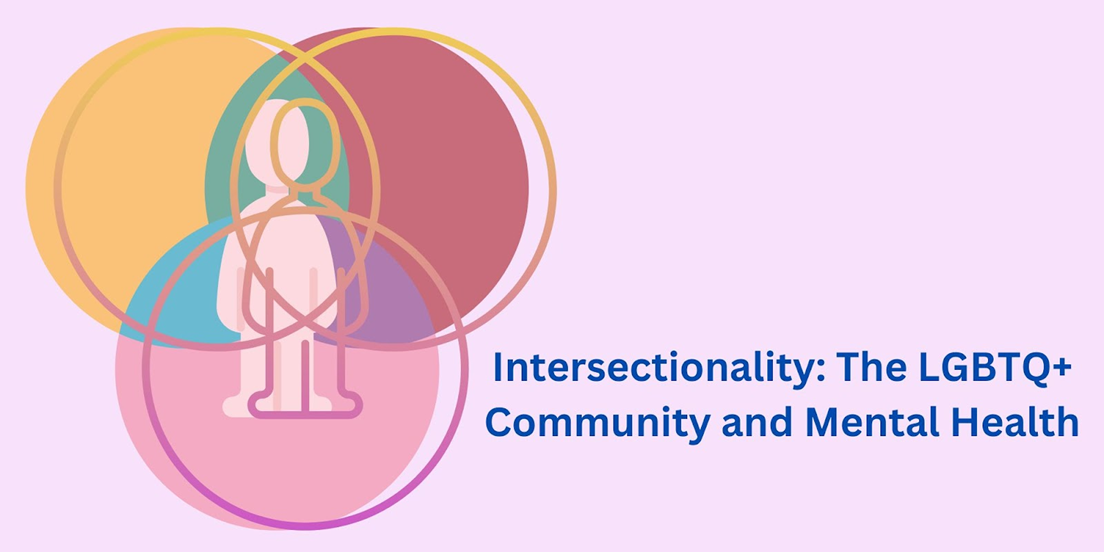
Explore Intersectionality: The LGBTQIA+ Community and Mental Health.

In the rapidly growing world, we all as humans are intertwined, interconnected, and co-existing with each other in several unique ways. One of the beautiful experiences of such co-living and intersection is with the LGBTQIA+ community. Understanding the nuanced layers of intersectionality and the level of complexities the community faces directly impacts their mental health.
Challenges Faced by The LGBTQIA+ Community
The challenges faced by the LGBTQIA+ community have been from all spheres, being physiological, psychological, and social as well.
To begin with, in formative years it is difficult at times to associate oneself with the biological assigned gender or challenges in the identity formation. To realise one's preferences and accommodate changes while growing up has been very confusing and stressful.
A lot of young adults lack enough exposure to have awareness about gender identity and sexual orientation, which adds to unsaid feelings of guilt and shame for feeling natural things. Traditionally speaking people are habitual of having conversations in non-binary and easily gender confirmation. Eventually it leaves no space for an individual to have natural own experiences.
The journey of self-realisation-acceptance-coming out is not only challenging but gives deep anxiety and traumas at times. Surviving in regressive and discriminating societal standards, intersectionality has such limited accessibility for anyone to live by their choice.
This is not only physically challenging but mentally suffocating too. The norms and standards of society see them from a prejudiced and discriminating lens which makes them feel unfitting and unacceptable.
Stigma And Cultural Barriers Have Been A Striking Force in Bothering The Mental Health of The LGBTQIA+ Community. Let’s Understand How.
The ways different social identities interconnect and cross one another's paths' have profound impacts on shaping their experience in coexisting with one another. Intersectionality is an attempt to highlight the same and understand its fine layers. Beyond the sexual orientation differences such as -
- race,
- ethnicity,
- caste,
- religion,
- class,
- socio-economic background,
- gender, and
- disabilities, several factors hamper the well-being of the LGBTQIA+ community. Fear of rejection being the minority and being deprived of several opportunities take a toll on their mental health.
Their population is slowly rising and comparatively less than other communities which keep refraining from equal rights and diversified culture. To understand it better, it is often witnessed in India that people belonging to a transgender community are exempted from work. These stereotypes often come to other community members based on their appearances and behaviour. This limits their chances to stand equal, but also their talent, capabilities, and struggles remain unhinged.
This is not only stressful for the future but also saddening for them. Whilst growing up in such complications, there are many instances of self-doubt seen in children where peers, and society often parents as well question their masculinity and femininity by the choice of dress, games to play, or simply a choice of colour. From a very young age struggle to first understand and then accept oneself has been no cakewalk for them, which just adds more troubles at certain times when comes to family and society. A lot of people have never seemed to develop the courage to come out and own their identity. Being able to embrace the rich diversity is rather suppressed and results in depression to them.
Furthermore, one does come across facing systematic racism resulting in prejudice, discrimination, and unjust treatment based on caste, race, and ethnic background. This is not only mentally but socially challenging as well, it can be manifested in various settings such as housing, work, educational institutions, etc. Have the horrifying experience of dampers a long-term traumatic effect on any individual. Lack of support and acceptance from oneself, family and society ends up one dwelling loneliness and isolation. The stigmas attached to intersectionality may bring events of harassment, bullying, and violence which cultivates feelings of shame and leaves one with self-doubts.
On a daily basis, people who have been homophobic take a fraction of a second to avoid any medium of contact with the LGBTQI+ community and straight away jump to rejection due to personal biases, but when these rejections are from family they exacerbate the feeling bringing shame and guilt to the family.
Cultural practices and religious beliefs are seen to deny the existence of the whole community, not they are not involved but also treat these orientations to be sinful. This creates an unnecessary exclusivity which might create barriers to mental health care for them. Such internalised stigmas, denial of support, and lack of LGBTQI+ affirmative providers contribute to mental health disturbances intersecting any identities. LGBTQ+ individuals may encounter barriers to accessing culturally competent and affirming mental health care. These barriers can include a lack of knowledgeable providers, affordability issues, concerns about confidentiality, and past negative experiences with healthcare professionals.
What Are The Ways to Fight These Stigma And Cultural Barriers
Perhaps serious steps to create an inclusive space of such intersectionality are need of the hour. There have to be fair and more gender-neutral practices instigated from early childhood in education and parenting to create a safe space for everyone. A non-judgmental, confidential, and validating environment is the relevant and minimal basis to be provided to anyone beyond their gender identity. Moving forward, good community resilient support could also be encouraged within the LGBTQI community itself, where it can be felt more alike and comfortable. Reliable sources, correct guidance, understanding, and solidarity could be more emphasised within all age groups.
Furthermore, serious policy changes are witnessed across many countries, where flexibility to engage in matrimony within the same sex has been acceptable. These path-breaking moves bring more empowerment with the intersectionalities. In proceeding towards development using language which are non gender conforming, asking for the preferred pronoun, and keeping more options on the gender-specific questions making public space more unisexual have been some practical and applicable steps. These also may benefit queer affirmative therapists, which are more specifically driven toward creating an inclusive space for everyone.
Conclusion -
In conclusion, the intersectionality of the LGBTQIA+ community and mental health reveals a complex interplay of social, cultural, and individual factors. These challenges need to be met with a multifaceted approach that can navigate policy change, be culturally compassionate, bring more empathy towards them, and provide community care and support. It is very crucial to address these issues and foster a welcoming and socially justified environment for anyone despite their intersecting identities.
image credit : freepik

How Psychotherapy Helps in Late-Life Depression And Anxiety: A Path to Healing, Hope, And Healthy Aging
How Social Isolation Impacts Geriatric Mental Health? How to Reverse It?

